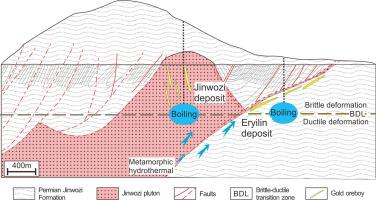Ore Geology Reviews ( IF 3.3 ) Pub Date : 2022-09-14 , DOI: 10.1016/j.oregeorev.2022.105099 Xi Chen , YanShuang Wu , KeFa Zhou , Yi Zheng , Fei Xiao , Yong Wang

|
The Eryiling gold deposit in the Jinwozi orefield is a carbonaceous strata-hosted gold deposit in the Beishan Orogen, NW China. The gold orebodies are mainly layered, lenticular, and vein hosted in Jinwozi Formation, different from the Jinwozi gold deposit. In this contribution, based on a comprehensive study including field investigation of ore geology, fluid inclusion microthermometry, and in situ sulfur isotopic composition, we discuss the origin and source of the ore fluids and the gold precipitation mechanism at the Eryiling deposit. The ore-forming process includes the early milky white quartz-pyrite vein, the main stage smokey gray quartz-sulfide vein, and the late-stage quartz-calcite vein. The auriferous vein characterizes the main-stage veins. By micro-thermometry, CO2-bearing(C-), Pure CO2(PC-), Water(W), and daughter crystal(S) types of fluid inclusions were identified and investigated. The early-stage quartz vein contains C-type FIs with a salinity of 3.5 to 7.7 wt% NaCl eqv., and total homogenization temperature (Th) of 243 and 321 °C. It shows that the ore fluids possess characters of low salinity, CO2-rich, and mesothermal. These characters resemble to those of orogenic-type gold deposits. The C-type FIs in the main stage quartz show salinity of 3.5 to 8.9 wt% NaCl eqv., and Th of 200 and 350 °C. The W-type FIs are coexisting with C-type FIs which they yield salinity of 5.5 to 10.2 wt% NaCl eqv., and Th of 158 – 287 °C. A large amount of immiscibility fluid inclusion assemblages found in the main stage quartz provide clear evidence for gold precipitation caused by fluid immiscibility. Trapping pressures of 61–233 MPa for the early stage and 48–182 MPa for the main stage are estimated, equivalent to mineralization depths of ∼ 8.1 km and ∼ 6.4 km, respectively. The δ34S value of sulfide increased from early-stage (average of 3.8 ‰) to main-stage (average of 6.4 ‰), indicating sulfur contributed by the wall rocks through fluid-rock interaction as the wall-rock sulfide display value of average of 16.2 ‰. In summary, the Eryiling gold deposit is situated in the altered carbonaceous rock of the Jinwozi Formation and regulated by a fractured zone, which could be considered a typical carbonaceous strata-bound orogenic gold deposit. Moreover, the similarity of ore-forming fluids between Jinwozi and Eryiling gold deposits indicates that they are the products of the same ore-forming fluid in different wall rocks.



























 京公网安备 11010802027423号
京公网安备 11010802027423号